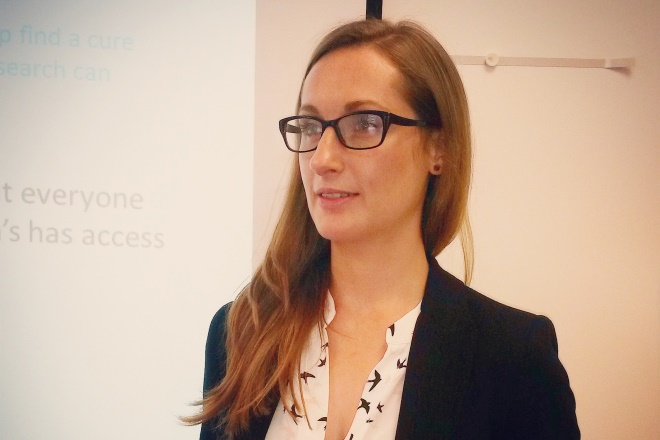
Source: Nicola Hawes / Shutterstock.com
More than three decades ago, patients with HIV and AIDS in the United States started to push pharmaceutical companies for treatments by getting informed and lobbying for more research. It proved a powerful driver for better drugs, better access, and better understanding of what the disease was.
But that level of patient power, on the whole, has not been replicated on the same scale in other diseases — at least not at the drug design and development stages. Any patient lobbying or involvement has tended to be in the post-marketing phase, or patient engagement has been stuck in pilot projects because companies were unsure of the value.
In other industries, it would seem odd not to get input from the end user of a product throughout the development stages. But it seems that pharmaceutical companies — some would say belatedly — are now waking up to the idea that getting meaningful patient input throughout the drug development life cycle could potentially save them a lot of money.

Source: Courtesy of Helena Chung
Helena Chung, patient engagement director at AstraZeneca, says: “The feedback from the team has been that it has inspired and encouraged them to think about how to make the science meaningful”
“We have to involve patients early and often. It is about improving the experience of the patient in a clinical trial, but it is also about developing the right medicine that reflects the patient need,” says Helena Chung, patient engagement director at pharmaceutical company AstraZeneca, based in Cambridge, UK.
It is about improving the experience of the patient in a clinical trial but it is also about developing the right medicine that reflects the patient need
In 2017, AstraZeneca launched a global patient partnership programme (PPP) to engage patients in the drug development process. Chung explains that the 68 members of the programme are involved in everything from scientific discovery and drug development, to disease management solutions and patient education. “PPP advisors are participating in global patient advisory boards and helping clinical and medical teams identify new ways to make science work for patients,” says Chung.
The programme has been particularly helpful in early stage development, where researchers would not normally have much input from patients. Patient involvement has fundamentally changed the way AstraZeneca’s researchers think about developing medicines, claims Chung. “The feedback from the team has been that it has inspired and encouraged them to think about how to make the science meaningful.”
Disease-specific groups have been set up, covering ovarian cancer, lung cancer, asthma, chronic obstructive pulmonary disease and systemic lupus erythematosus, with other groups, including type 2 diabetes mellitus and chronic kidney disease in the pipeline.
Together with PPP advisors, the company has co-created patient-friendly clinical study protocols, clinical study information and informed consent forms, and a post-study trial results lay summary web portal that is easy to access and navigate for patients and carers.
Putting patients first
‘Patient centricity’ is a buzzword within the pharmaceutical industry and AstraZeneca has done some work to try to pin down what this phrase means. This led to the following definition: “Putting the patient first in an open and sustained engagement of the patient to respectfully and compassionately achieve the best outcome for that patient and their family.”
The company has also put together ten ‘key principles of patient centricity’, which were published in BMJ Innovations
[1]
. In the paper, AstraZeneca calls on biopharmaceutical companies to adopt its definition and principles as a reference point of what patient engagement should look like.
“It does have to be done in a meaningful way, [so that] patients can see that it is not just a tick-box exercise,” says Chung. “The ultimate end point is that patients having a seat at the table is the norm and not the exception.”

Source: Courtesy of Paul Robinson
Paul Robinson, European lead in patient innovation at MSD, believes that the pharmaceutical industry is starting to take patient centricity more seriously
Paul Robinson, European lead in patient innovation at New Jersey-based pharmaceutical giant MSD, says that involving patients in the design of clinical trials can have a striking impact. He believes that, while it is early days, the pharmaceutical industry is starting to take patient centricity more seriously.
It has been a slow evolution, but we seem to have reached a critical mass — everyone is starting to see the value of talking, and listening, to patients
“It has been a slow evolution, but we seem to have reached a critical mass. Everyone is starting to see the value of talking, and listening, to patients,” he says, adding that many companies are realising they are missing a trick if they do not listen to the needs of their ultimate consumer.
Simon Denegri, national director for patients, carers and the public at the National Institute of Health Research, says he has noticed a real shift in the past five years in how pharmaceutical companies engage with patients. “It is important that organisations take a pragmatic view of this — to make it work they have to identify a place to begin and to build confidence,” he says.
Patient feedback can lead to some important changes in how trials are put together, which in turn could result in real improvements to enrolment and adherence. For example, a patient input scheme in one of MSD’s advanced cancer programmes highlighted that the proposed comparator drug had already been tried by many patients early in their disease, so they would not want to run the risk of being randomised to it again.
“Patients also had very clear views that they wanted the chance to switch over to the trial drug at the end of the study,” explains Robinson.
Of course, the needs of the patient have to be balanced with what regulators will accept. But if you can identify the potential hurdles in getting patients to sign up to, and stick with, trials, the impact on the speed of getting a drug to market can be significant.
Return on investment
A recent study looking at return on investment for engaging patients in trial design showed staggering results[2]
.
Researchers in the United States based their calculations on a typical oncology development programme, where a patient review of the pre-phase II protocol had resulted in avoiding one amendment to the trial (which in itself can cause a three-month delay), had increased enrolment and adherence, and reduced drop-out rates.
The cumulative impact on the expected net present value (ENPV) — a measure of cost, time, revenue, and risk — was found to be US$35m, rising to US$75m by phase III.
Depending on the scenario, the researchers say a US$100,000 investment in patient engagement in the design of a trial could produce an ENPV 500 times that figure.
The team calculated that the most conservative estimate is that 15% of protocols reviewed by patients would end up being changed. And anecdotal experience from those who have carried out such work suggests that input from patients can certainly be valuable.
Another example is the case of Brussels-based biopharmaceutical company UCB Pharma, which recently teamed up with research and support charity Parkinson’s UK to carry out two patient engagement workshops — one looking at outcome measures and another looking at the design of a clinical trial. These workshops stemmed from a patient value strategy adopted by UCB in 2015 that aims to include patients at every stage of a medicine’s life cycle.
What patients want
Kate Trenam, UK and Ireland patient advocacy lead for UCB, says the feedback from patients has already been incorporated into the study design for the clinical trial in question.
It has had a big impact and our global patient engagement team is now thinking about the best way to involve research and development patient panels
“It was around how to make visits more patient-friendly and adjusting the schedule to fit patients’ lives. The clinical team is also reviewing the drug formulation and packaging based on the insights gathered.
“It has had a big impact and our global patient engagement team is now thinking about the best way to involve research and development patient panels.”
She adds: “This is just the beginning. It is being driven by both industry and patients who want to develop solutions to unmet needs.”
Paul Burns from the West Midlands is one of the patients who took part in the UCB/Parkinson’s UK project. He says it is vital that patients are consulted because patients and academics have different ideas about what patients want from a medicine.
“They asked, aside from a complete cure, what would you want from a medicine, and the answer from everyone was a time delay in the passage of the disease.
“Researchers are looking at helping with tremor or bladder problems but slowing down the progress of the disease — they were very surprised [that’s what patients wanted].”
Burns points to a 2017 paper in the Orphanet Journal of Rare Diseases which concluded that existing research methods fall short of consistently measuring the full range of outcomes that matter to patients[3]
.
“We were told in one of the workshops we probably saved the pharmaceutical company millions [of pounds] on an aspect of the research they had set off on.”

Source: Courtesy of Claire Nolan
Claire Nolan, research involvement manager at Parkinson’s UK, says that the Association of the British Pharmaceutical Industry’s code of practice is frequently cited by pharmaceutical companies as a barrier to engaging with patients
Claire Nolan, research involvement manager at Parkinson’s UK, says the partnership with UCB highlights that medical charities have the experience to help pharmaceutical companies work out how to involve patients in research and development.
Alongside Chris Macdonald at charity Arthritis Research UK, Parkinson’s UK has been working with the Association of the British Pharmaceutical Industry (ABPI) on strategies for how charities can help pharmaceutical companies with patient engagement.
Arthritis Research UK has worked with a number of industry partners, including Pfizer, where patient input led to the introduction of fatigue diaries in trial protocols.
There is a conflation that people think patient engagement and involvement is just disseminating information — it has to be a dialogue
One aspect the charity is clear on, says Macdonald, is that it has to be a partnership.
“There is a conflation that people think patient engagement and involvement is just disseminating information — it has to be a dialogue.”
Macdonald believes that the pharmaceutical industry has been slow to incorporate meaningful patient engagement. “What I would like to see is every single pharmaceutical company having a patient advisory group for every single condition, working as partners in making decisions about their programmes as a whole,” he says.
Guidelines
Measuring impact and developing clear guidelines for how to engage with patients without falling foul of European regulations are crucial to ensuring pharmaceutical companies take patient engagement seriously.
Nolan believes that regulators, such as the European Medicines Agency, as well as trade associations, such as the ABPI, have a role to play in making it clear to pharmaceutical companies that not only is patient engagement acceptable, it is something they should be doing.
In the UK, the code of conduct is frequently cited as a barrier by pharmaceutical companies who don’t think they can engage with patients in this way
“Certainly in the UK, the [ABPI] code of practice is frequently cited as a barrier by pharmaceutical companies who don’t think they can engage with patients in this way,” he says. “We are doing a bit of work with the ABPI at the moment to talk about this and I would like to see more guidance for companies on it.”
A spokesperson for the ABPI says that it is working on guidance, bearing in mind the requirements in the ABPI code of practice covering relationships between pharmaceutical companies, patients and patient organisations. The ABPI has just launched a consultation on changes to the code, which will run until October 2018. “We know that engagement with patients is very important to pharmaceutical companies but, understandably, they want and need to make sure they get it absolutely right and operate with the highest ethical, transparent and professional standards,” the spokesperson says.
Robinson is involved in a European public–private partnership called Patients Active in Research and Dialogues for an Improved Generation of Medicines (Paradigm), co-led by the European Patients’ Forum and European Federation of Pharmaceutical Industries and Associations, and set up to “advance meaningful patient engagement in the medicines life cycle”.
He says the patient engagement movement’s current goal is to make it more routine and help companies and patients figure out how it can happen.
“One of the workstreams in Paradigm is about metrics. The ‘$64m question’ is how do we decide if this is a valuable thing to do,” says Robinson.
It is about a subtle culture change that says there is value in this and here is the process by which you can do it
While it is not all about the bottom line, pharmaceutical companies are likely to value some measures of efficiency, he adds.
“What we’re also trying to do [through] Paradigm is develop guidelines on how companies can safely engage with patients. It is about a subtle culture change that says there is value in this and here is the process by which you can do it.”

Source: Courtesy of Nicholas Brooke
Nicholas Brooke, executive director of Patient Focused Medicines Development, says the majority of pharmaceutical companies can now see the positive value of patient engagement even if they are not yet sure how to go about it
That is also the goal of the global coalition, Patient Focused Medicines Development, which is attempting to bring together ‘disparate but complementary’ efforts to better patient engagement in medicines research. Its executive director Nicholas Brooke says the coalition’s role is to bring industry and patient organisations together to work out where the barriers might be and how to overcome them.
Fragmentation
One of the problems the coalition identified is fragmentation — both in terms of pockets of excellence within individual research and development teams that are not shared across the company, and in terms of the expectations of stakeholders within different disease areas about what patient involvement could be or do.
What is needed, he says, is standards and methodologies to better connect what people are already doing, rather than trying to reinvent the wheel.
The result of the coalition’s work is ‘Synapse’ — an online platform that ‘maps’ patient engagement initiatives and resources, which so far includes 247 initiatives, 183 organisations and 687 users.
“Rather than starting from scratch, anyone who wants to do patient engagement, say at phase III, can look what has already been done,” explains Brooke. “We need to break down these silos.”
He says the majority of pharmaceutical companies can now see the positive value of patient engagement, even if they are not yet sure how to go about it. But there are some who are yet to be convinced.
Getting over the cultural barriers and figuring out how to do it can be a difficult jump to make, he adds. “We have identified 150 activities you can do with patients to create value for more innovative drugs.” The list of activities was open for public consultation until 14 September 2018.
What will also make a difference, Brooke adds, is having the evidence to make a business case for it. “We have been developing drugs in one way for decades and change is hard. But there is more and more evidence. There is no excuse not to do it anymore.”
My hope is that patient engagement becomes the norm, that we shorten the cycle of drug development, waste much less money and deliver more meaningful drugs to market
Companies who are slow to adopt patient engagement will lose their competitive advantage, he warns.
“My hope is that patient engagement becomes the norm, that we shorten the cycle of drug development, waste much less money and deliver more meaningful drugs to market.”
There is little there for anyone to disagree with but Michael Seres, founder and chief executive officer of connected medical device company 11health, who has worked with multiple organisations on patient involvement, wants to see pharmaceutical companies go much further.
“On the board of every single drug company there should be a chief patient officer who has a strategic role and responsibility with their core job to be the deliverer of true patient engagement at all levels of the company,” he says.
Seres, who was diagnosed with Crohn’s disease at the age of 12 years, says there is definitely a growing trend towards patient centricity, but the jury is still out on whether it is genuine or merely lip service. “There is a will to appreciate that times are changing, but I’m not yet seeing a real bravery from pharmaceutical companies to say we’re really going to embed patients — it is very early days.”
Panel 1: Academia is leading the way
UK academia is one sector that is ahead of the game in terms of patient engagement, says Claire Nolan, research involvement manager at Parkinson’s UK, mainly because the National Institute for Health Research (NIHR), which funds clinical research in the UK, has insisted on it.
From its inception in 2006, the NIHR has involved the public throughout its whole research cycle, says Simon Denegri, its national director for patients, carers and the public. It has achieved this in several ways, he says, such as the clear expectation that funding applicants would have to have patient involvement embedded within their own structures, which today means 200 public involvement leads dotted around the country.
“We were probably the only organisation at the time which said we are going to do this, and we were very conscious we were in an influential position,” says Denegri.
But, even now, defining what real public engagement should look like or the right way to do it is not clear, he says.
“In March 2018, we published some standards which we are currently testing and hope to finalise next year.
“We are also evaluating the impact [of patient involvement], which is a much harder task. The next challenge for the UK is to determine some clear impact measures, which everyone can have confidence in.”
References
[1] Yeoman G, Furlong P, Seres M et al. Defining patient centricity with patients for patients and caregivers: a collaborative endeavour. BMJ Innov 2017;3(2):76–83. doi: 10.1136/bmjinnov-2016-000157
[2] Levitan B, Getz K, Eisenstein EL et al. Assessing the financial value of patient engagement: a quantitative approach from CTTI’s patient groups and clinical trials project. Ther Innov Regul Sci 2018;52(2):220–229. doi: 10.1177/2168479017716715
[3] Morel T & Cano SJ. Measuring what matters to rare disease patients – reflections on the work by the IRDiRC taskforce on patient-centered outcome measures. Orphanet J Rare Dis 2017;12:171. doi: 10.1186/s13023-017-0718-x

